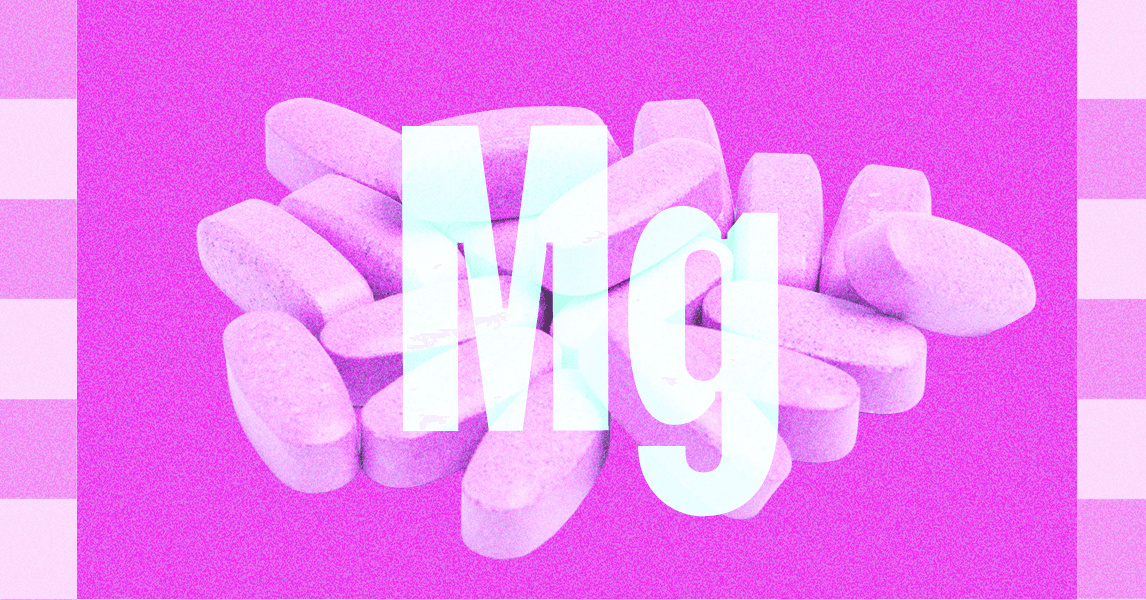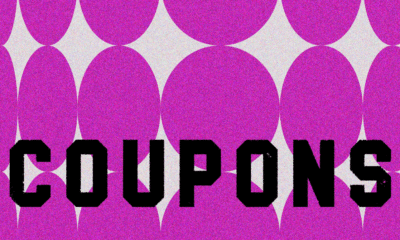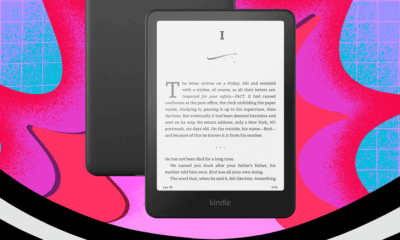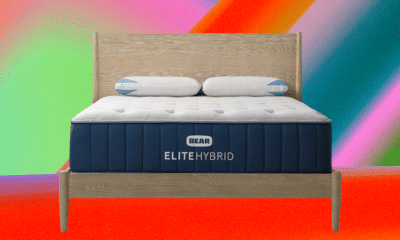Tech
Should I Take Magnesium Supplements? Everything You Need to Know

Suddenly, everyone is obsessed with magnesium supplements. It’s the key ingredient in #sleepygirlmocktails, powders stirred into tart cherry juice and prebiotic soda, a wellness cocktail for anxious millennials. Your coworkers are popping magnesium glycinate before bed instead of melatonin, because it allegedly cures insomnia, constipation, and existential dread. Folks seem especially concerned with optimizing their poop and pillow time. In the past year, Google searches for “which magnesium is best for sleep” and “which magnesium makes you poop” have more than doubled.
Magnesium is essential for maintaining a healthy cardiovascular system. It’s also one of the most abundant minerals in the human body, running more than 300 biochemical reactions, from protein synthesis to nerve function and blood sugar regulation. It supports bone structure and helps shuttle calcium and potassium across cell membranes, a process that allows for muscle contractions and normal heart rhythms.
You can get it from foods like legumes, leafy vegetables, and whole grains, or from fortified foods and dietary supplements. The question is: Do you need to supplement?
TikTok content
This content can also be viewed on the site it originates from.
Symptoms of Magnesium Deficiency
While an essential mineral for overall health, many people don’t get enough magnesium. This is partly because magnesium is predominantly found in high-fiber foods, and a significant portion of Americans do not consume sufficient fiber, according to registered dietitian Sue-Ellen Anderson-Haynes. Research confirms this: More than 90 percent of women and 97 percent of men fail to meet the recommended daily intake for dietary fiber.
Older adults are particularly at risk, as the body’s ability to absorb magnesium decreases with age. Health conditions like Crohn’s disease or kidney disease, alcohol use disorder, and the use of diuretics can all lead to magnesium depletion.
Anderson-Haynes notes that a magnesium deficiency (also known as hypomagnesemia) can result in a range of symptoms, such as headaches, nausea, constipation, tremors, heart palpitations, and muscle soreness. Chronic magnesium deficiency can increase the risk of developing high blood pressure, osteoporosis, insulin resistance, and type 2 diabetes.
Benefits of Magnesium Supplements
There are several forms of magnesium supplements, including:
- Magnesium citrate: Often taken as a remedy for occasional constipation.
- Magnesium glycinate: Often taken for better sleep and reduced anxiety.
- Magnesium oxide: Often taken for constipation or indigestion.
- Magnesium l-threonate: Often taken for better sleep, cognitive function, and reduced stress.
- Magnesium chloride: Often taken as an electrolyte replenisher and for its laxative effect.
Supplements are most useful for people with a confirmed deficiency, but early research suggests possible benefits for specific conditions, including migraines, insomnia, and cardiovascular disease.
“It’s really overlooked that magnesium can help with menstrual cycle irregularity in terms of making sure that you’re not having severe cramping,” says Anderson-Haynes, who adds it may also benefit women in perimenopause and menopause. Clinically, it may be part of the treatment for pregnancy complications like preeclampsia and eclampsia.
Can You Take Too Much?
The recommended dietary allowance is 320 milligrams per day for women and 420 milligrams per day for men. These are amounts most people can reach with a balanced diet; healthy kidneys regulate magnesium levels, excreting excess when magnesium intake is high and conserving it when it’s low.
Daily supplements under 350 milligrams are generally considered safe for healthy adults. “If you take too much magnesium, you’ll probably get diarrhea, because it loosens the bowels,” Anderson-Haynes says. Other side effects include nausea, gastrointestinal discomfort, and, at very high levels of magnesium (usually from overusing laxatives or antacids), low blood pressure, muscle cramps, breathing problems, and, in rare cases, cardiac arrest. People with kidney disease are at the highest risk of toxicity.
Should You Supplement?
For most healthy adults, magnesium supplements aren’t essential. If you struggle with migraines, insomnia, or other conditions where research suggests health benefits, they may be worth trying—but first talk to a health care professional.
Otherwise, focus on magnesium-rich foods. These include but are not limited to: legumes (beans, lentils, chickpeas), leafy greens (artichokes, kale, spinach), whole grains (oats, barley, quinoa), nuts (almonds, cashews, peanuts), fruit (bananas, avocado, dried apricots), and soy products (tofu, soy milk, edamame).
If you do decide to take any dietary supplements, “look for a seal or certification that says GMP (Good Manufacturing Practices) or NSF,” says Anderson-Haynes, stressing the importance of third-party tests and verifications, considering the FDA doesn’t regulate dietary supplements in the US.
Meet the Experts
- Sue-Ellen Anderson-Haynes, MS, RDN, CDCES, is a spokesperson for the Academy of Nutrition and Dietetics and founder of 360Girls&Women.
Power up with unlimited access to WIRED. Get best-in-class reporting and exclusive subscriber content that’s too important to ignore. Subscribe Today.
Tech
BMW Is Betting Big on the New iX3. The Good News Is It’s Superb

BMW’s first car on its new EV platform has finally arrived. But will a big range, thumping charging tech, and a new driving brain that aims to deliver the ultimate ride be enough to beat China?
Source link
Tech
MIT engineers design an aerial microrobot that can fly as fast as a bumblebee

In the future, tiny flying robots could be deployed to aid in the search for survivors trapped beneath the rubble after a devastating earthquake. Like real insects, these robots could flit through tight spaces larger robots can’t reach, while simultaneously dodging stationary obstacles and pieces of falling rubble.
So far, aerial microrobots have only been able to fly slowly along smooth trajectories, far from the swift, agile flight of real insects — until now.
MIT researchers have demonstrated aerial microrobots that can fly with speed and agility that is comparable to their biological counterparts. A collaborative team designed a new AI-based controller for the robotic bug that enabled it to follow gymnastic flight paths, such as executing continuous body flips.
With a two-part control scheme that combines high performance with computational efficiency, the robot’s speed and acceleration increased by about 450 percent and 250 percent, respectively, compared to the researchers’ best previous demonstrations.
The speedy robot was agile enough to complete 10 consecutive somersaults in 11 seconds, even when wind disturbances threatened to push it off course.
Credit: Courtesy of the Soft and Micro Robotics Laboratory
“We want to be able to use these robots in scenarios that more traditional quad copter robots would have trouble flying into, but that insects could navigate. Now, with our bioinspired control framework, the flight performance of our robot is comparable to insects in terms of speed, acceleration, and the pitching angle. This is quite an exciting step toward that future goal,” says Kevin Chen, an associate professor in the Department of Electrical Engineering and Computer Science (EECS), head of the Soft and Micro Robotics Laboratory within the Research Laboratory of Electronics (RLE), and co-senior author of a paper on the robot.
Chen is joined on the paper by co-lead authors Yi-Hsuan Hsiao, an EECS MIT graduate student; Andrea Tagliabue PhD ’24; and Owen Matteson, a graduate student in the Department of Aeronautics and Astronautics (AeroAstro); as well as EECS graduate student Suhan Kim; Tong Zhao MEng ’23; and co-senior author Jonathan P. How, the Ford Professor of Engineering in the Department of Aeronautics and Astronautics and a principal investigator in the Laboratory for Information and Decision Systems (LIDS). The research appears today in Science Advances.
An AI controller
Chen’s group has been building robotic insects for more than five years.
They recently developed a more durable version of their tiny robot, a microcassette-sized device that weighs less than a paperclip. The new version utilizes larger, flapping wings that enable more agile movements. They are powered by a set of squishy artificial muscles that flap the wings at an extremely fast rate.
But the controller — the “brain” of the robot that determines its position and tells it where to fly — was hand-tuned by a human, limiting the robot’s performance.
For the robot to fly quickly and aggressively like a real insect, it needed a more robust controller that could account for uncertainty and perform complex optimizations quickly.
Such a controller would be too computationally intensive to be deployed in real time, especially with the complicated aerodynamics of the lightweight robot.
To overcome this challenge, Chen’s group joined forces with How’s team and, together, they crafted a two-step, AI-driven control scheme that provides the robustness necessary for complex, rapid maneuvers, and the computational efficiency needed for real-time deployment.
“The hardware advances pushed the controller so there was more we could do on the software side, but at the same time, as the controller developed, there was more they could do with the hardware. As Kevin’s team demonstrates new capabilities, we demonstrate that we can utilize them,” How says.
For the first step, the team built what is known as a model-predictive controller. This type of powerful controller uses a dynamic, mathematical model to predict the behavior of the robot and plan the optimal series of actions to safely follow a trajectory.
While computationally intensive, it can plan challenging maneuvers like aerial somersaults, rapid turns, and aggressive body tilting. This high-performance planner is also designed to consider constraints on the force and torque the robot could apply, which is essential for avoiding collisions.
For instance, to perform multiple flips in a row, the robot would need to decelerate in such a way that its initial conditions are exactly right for doing the flip again.
“If small errors creep in, and you try to repeat that flip 10 times with those small errors, the robot will just crash. We need to have robust flight control,” How says.
They use this expert planner to train a “policy” based on a deep-learning model, to control the robot in real time, through a process called imitation learning. A policy is the robot’s decision-making engine, which tells the robot where and how to fly.
Essentially, the imitation-learning process compresses the powerful controller into a computationally efficient AI model that can run very fast.
The key was having a smart way to create just enough training data, which would teach the policy everything it needs to know for aggressive maneuvers.
“The robust training method is the secret sauce of this technique,” How explains.
The AI-driven policy takes robot positions as inputs and outputs control commands in real time, such as thrust force and torques.
Insect-like performance
In their experiments, this two-step approach enabled the insect-scale robot to fly 447 percent faster while exhibiting a 255 percent increase in acceleration. The robot was able to complete 10 somersaults in 11 seconds, and the tiny robot never strayed more than 4 or 5 centimeters off its planned trajectory.
“This work demonstrates that soft and microrobots, traditionally limited in speed, can now leverage advanced control algorithms to achieve agility approaching that of natural insects and larger robots, opening up new opportunities for multimodal locomotion,” says Hsiao.
The researchers were also able to demonstrate saccade movement, which occurs when insects pitch very aggressively, fly rapidly to a certain position, and then pitch the other way to stop. This rapid acceleration and deceleration help insects localize themselves and see clearly.
“This bio-mimicking flight behavior could help us in the future when we start putting cameras and sensors on board the robot,” Chen says.
Adding sensors and cameras so the microrobots can fly outdoors, without being attached to a complex motion capture system, will be a major area of future work.
The researchers also want to study how onboard sensors could help the robots avoid colliding with one another or coordinate navigation.
“For the micro-robotics community, I hope this paper signals a paradigm shift by showing that we can develop a new control architecture that is high-performing and efficient at the same time,” says Chen.
“This work is especially impressive because these robots still perform precise flips and fast turns despite the large uncertainties that come from relatively large fabrication tolerances in small-scale manufacturing, wind gusts of more than 1 meter per second, and even its power tether wrapping around the robot as it performs repeated flips,” says Sarah Bergbreiter, a professor of mechanical engineering at Carnegie Mellon University, who was not involved with this work.
“Although the controller currently runs on an external computer rather than onboard the robot, the authors demonstrate that similar, but less precise, control policies may be feasible even with the more limited computation available on an insect-scale robot. This is exciting because it points toward future insect-scale robots with agility approaching that of their biological counterparts,” she adds.
This research is funded, in part, by the National Science Foundation (NSF), the Office of Naval Research, Air Force Office of Scientific Research, MathWorks, and the Zakhartchenko Fellowship.
Tech
Thursday’s Cold Moon Is the Last Supermoon of the Year. Here’s How and When to View It

A cold supermoon is on its way. On December 4, Earth’s satellite will delight us with one of the last astronomical spectacles of 2025. Not only will it be the last full moon of the year, but it’s also a cold moon—which refers to the frigid temperatures typical of this time of year—and, finally, a supermoon. Here’s how and when best to enjoy this spectacle of the year-end sky.
What Is a Supermoon?
The term supermoon refers to a full moon that occurs when our satellite is at perigee, the point at which its orbit brings it closest to our planet. (The moon’s orbit is elliptical, and its distance from Earth varies between about 407,000 km at apogee, the point of maximum distance, and about 380,000 at perigee.)
In addition to being the third consecutive supermoon of the year, as reported by EarthSky, it will be about 357,000 km away from us, making it the second-closest full Moon of the year. Consequently it will also be the second-largest and brightest.
Although most of us won’t notice any difference in size compared to a normal full moon (it appears up to 8 percent larger to us), its brightness could exceed that of an ordinary full Moon by 16 percent. This time, moreover, it will be 100 percent illuminated just 12 hours after its perigee.
The Cold Supermoon
In addition to its name, which refers to the cold temperatures of this period, December’s full moon will be the last of 12 full moons in 2025 and the highest of the year. With the winter solstice approaching on December 21, the sun is at its lowest point in the sky, so the full moon is at its highest point. In other words, this means that the super cold moon will be particularly high in the sky. As EarthSky points out, however, it is not the closest full Moon to the December 21 solstice. While it occurs 17 days before, the first full moon of 2026 will occer on January 3—just 12 days ater teh solstice. That will be the fourth and last consecutive supermoon.
How to Enjoy the Show
Although the moon may appear full both the night before and the night after, the exact time of the full moon is scheduled for 6:14 pm ET on Thursday, December 4. In general, moonrise is the best time to be subject to the so-called lunar illusion, during which the moon appears larger than usual to us. NASA still doesn’t have a scientific explanation for why this happens, but as you might expect, the effect is greatest during a supermoon. Weather permitting, therefore, find an elevated place or meadow with an unobstructed view of the eastern horizon and enjoy the last moon show of the year.
This story originally appeared on WIRED Italia and has been translated from Italian.
-

 Sports3 days ago
Sports3 days agoIndia Triumphs Over South Africa in First ODI Thanks to Kohli’s Heroics – SUCH TV
-

 Tech4 days ago
Tech4 days agoGet Your Steps In From Your Home Office With This Walking Pad—On Sale This Week
-

 Fashion3 days ago
Fashion3 days agoResults are in: US Black Friday store visits down, e-visits up, apparel shines
-

 Politics3 days ago
Politics3 days agoElon Musk reveals partner’s half-Indian roots, son’s middle name ‘Sekhar’
-

 Entertainment3 days ago
Entertainment3 days agoSadie Sink talks about the future of Max in ‘Stranger Things’
-

 Tech3 days ago
Tech3 days agoPrague’s City Center Sparkles, Buzzes, and Burns at the Signal Festival
-
Uncategorized1 week ago
[CinePlex360] Please moderate: “Americans would
-

 Tech1 week ago
Tech1 week agoWake Up—the Best Black Friday Mattress Sales Are Here


















